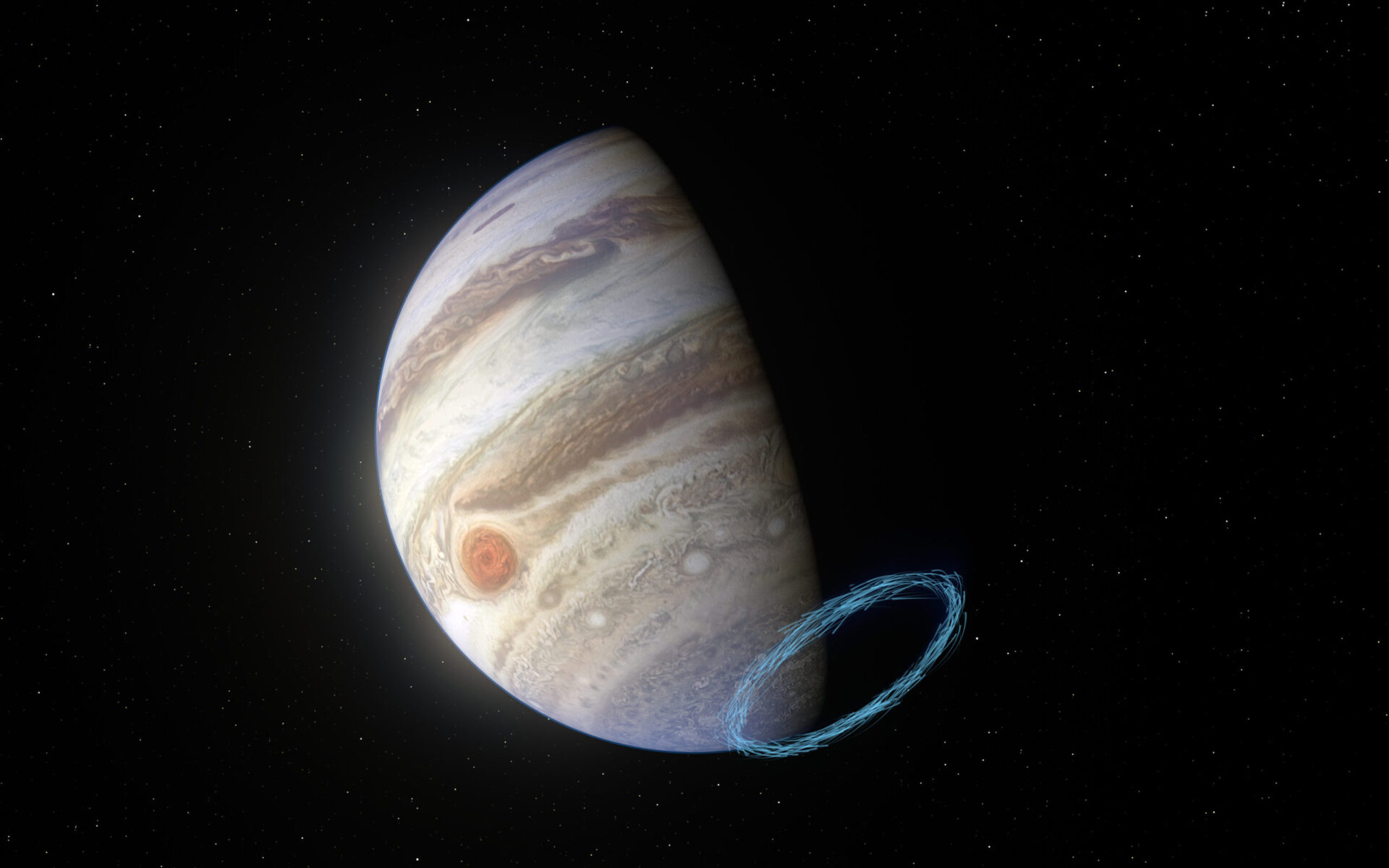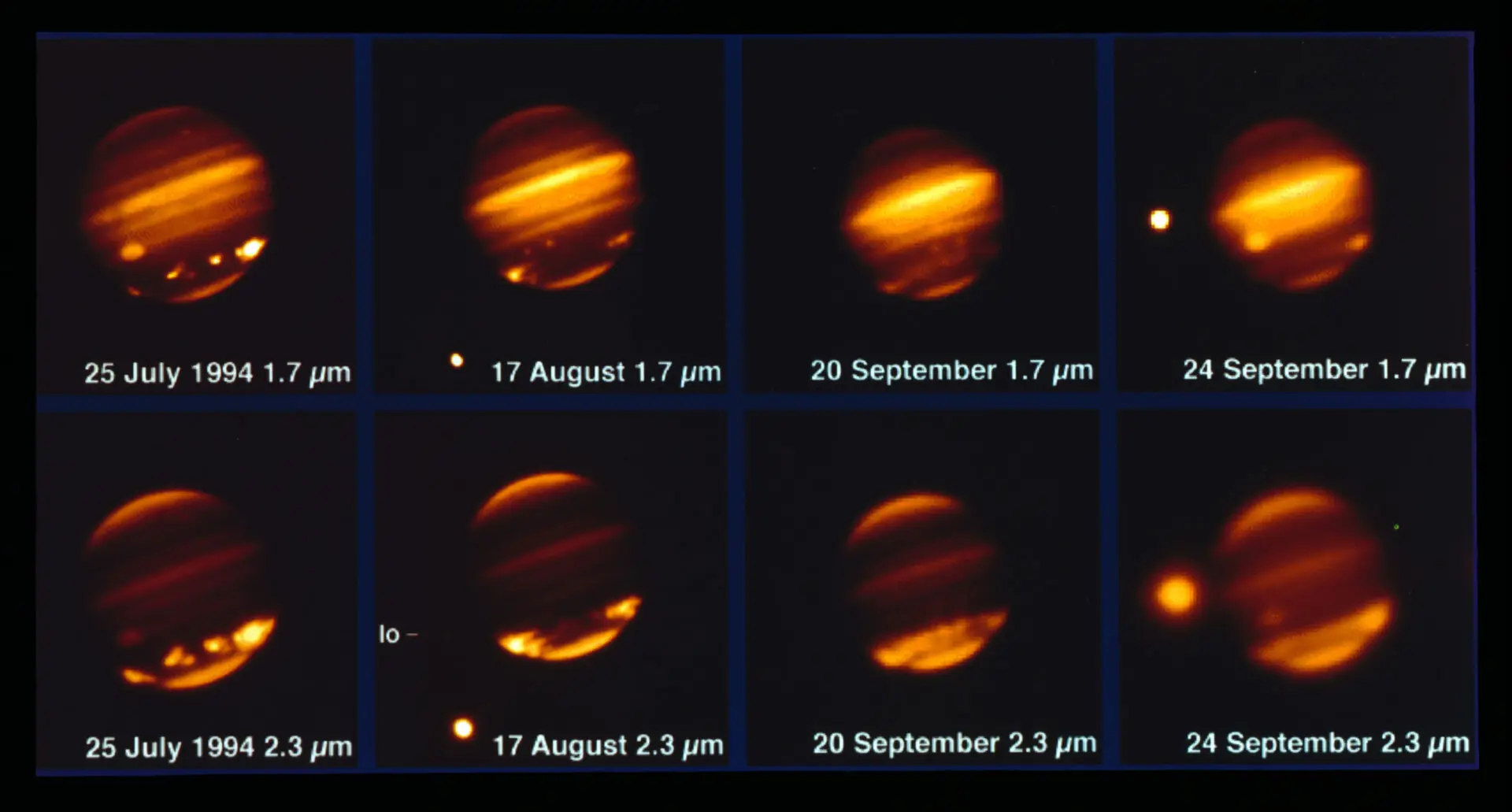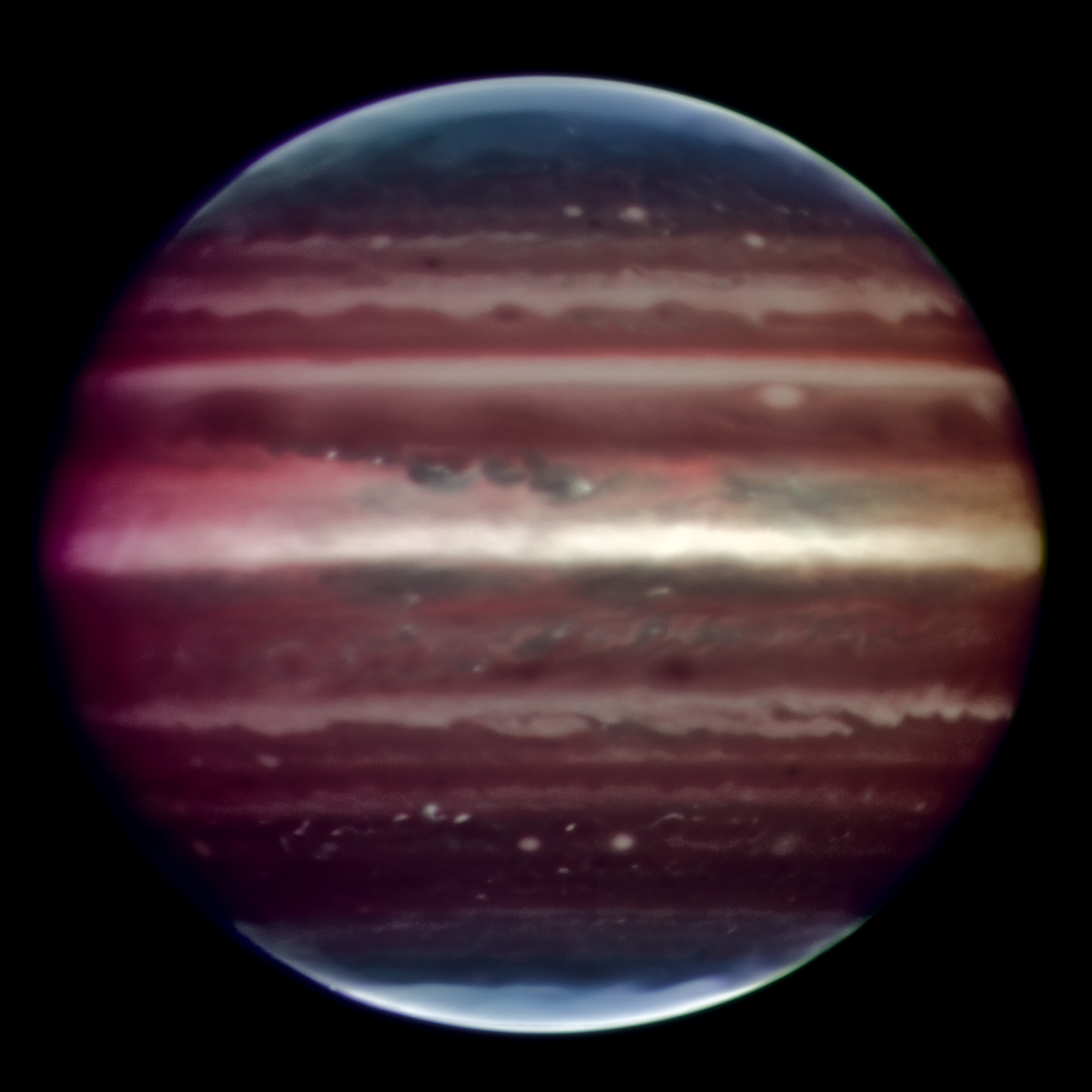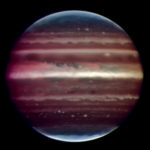Powerful stratospheric winds measured on Jupiter for the first time
Using the Atacama Large Millimeter/submillimeter Array (ALMA), a team of astronomers have directly measured winds in Jupiter's middle atmosphere for the first time. By analyzing the aftermath of a comet collision from the 1990s, the researchers have revealed incredibly powerful winds, with speeds of up to 1450 kilometers an hour, near Jupiter's poles. They could represent what the team has described as a "unique meteorological beast in our Solar System."
Jupiter is famous for its distinctive red and white bands: swirling clouds of moving gas that astronomers traditionally use to track winds in Jupiter's lower atmosphere. Astronomers have also seen, near Jupiter's poles, the vivid glow known as aurorae, which appear to be associated with strong winds in the planet's upper atmosphere. But until now, researchers had never been able to directly measure wind patterns between these two atmospheric layers in the stratosphere.
Measuring wind speeds in Jupiter's stratosphere using cloud-tracking techniques is impossible because of the absence of clouds in this part of the atmosphere. However, astronomers were provided with an alternative measuring aid in the form of comet Shoemaker-Levy 9, which collided with the gas giant spectacularly in 1994. This impact produced new molecules in Jupiter's stratosphere, where they have been moving with the winds ever since.
A team of astronomers, led by Thibault Cavalié of the Laboratoire d'Astrophysique de Bordeaux in France, have now tracked one of these molecules — hydrogen cyanide — to directly measure stratospheric "jets" on Jupiter. Scientists use the word "jets" to refer to narrow bands of wind in the atmosphere, like Earth's jet streams.
"The most spectacular result is the presence of strong jets, with speeds of up to 400 meters per second, which are located under the aurorae near the poles," says Cavalié. These wind speeds, equivalent to about 1450 kilometers an hour, are more than twice the maximum storm speeds reached in Jupiter's Great Red Spot and over three times the wind speed measured on Earth's strongest tornadoes.
"Our detection indicates that these jets could behave like a giant vortex with a diameter of up to four times that of Earth and some 900 kilometers in height," explains co-author Bilal Benmahi, also of the Laboratoire d'Astrophysique de Bordeaux. "A vortex of this size would be a unique meteorological beast in our Solar System," Cavalié adds.
Astronomers were aware of strong winds near Jupiter's poles but much higher up in the atmosphere, hundreds of kilometers above the new study's focus area, which is published today in Astronomy & Astrophysics. Previous studies predicted that these upper-atmosphere winds would decrease in velocity and disappear well before reaching as deep as the stratosphere. "The new ALMA data tell us the contrary," says Cavalié, adding that finding these strong stratospheric winds near Jupiter's poles was a "real surprise".
The team used 42 of ALMA's 66 high-precision antennas, located in the Atacama Desert in northern Chile, to analyze the hydrogen cyanide molecules moving around in Jupiter's stratosphere since the impact of Shoemaker-Levy 9. The ALMA data allowed them to measure the Doppler shift — tiny changes in the frequency of the radiation emitted by the molecules — caused by the winds in this region of the planet. "By measuring this shift, we were able to deduce the speed of the winds much like one could deduce the speed of a passing train by the change in the frequency of the train whistle," explains study co-author Vincent Hue, a planetary scientist at the Southwest Research Institute in the US.
In addition to the surprising polar winds, the team also used ALMA to confirm the existence of strong stratospheric winds around the planet's equator by directly measuring their speed, also for the first time. The jets spotted in this part of the planet have average speeds of about 600 kilometers an hour.
The ALMA observations required to track stratospheric winds in both the poles and equator of Jupiter took less than 30 minutes of telescope time. "The high levels of detail we achieved in this short time really demonstrate the power of the ALMA observations," says Thomas Greathouse, a scientist at the Southwest Research Institute in the US and co-author of the study. "It is astounding to me to see the first direct measurement of these winds."
"These ALMA results open a new window for the study of Jupiter's auroral regions, which was really unexpected just a few months back," says Cavalié. "They also set the stage for similar yet more extensive measurements to be made by the JUICE mission and its Submillimetre Wave Instrument," Greathouse adds, referring to the European Space Agency's JUpiter ICy moons Explorer, which is expected to launch into space next year.
ESO's ground-based Extremely Large Telescope (ELT), set to see first light later this decade, will also explore Jupiter. The telescope will be capable of making highly detailed observations of the planet's aurorae, giving us further insight into Jupiter's atmosphere.
Additional Information
This research is presented in the paper "First direct measurement of auroral and equatorial jets in the stratosphere of Jupiter" published today in Astronomy & Astrophysics (doi:10.1051/0004-6361/202140330).
The team is composed of T. Cavalié (Laboratoire d’Astrophysique de Bordeaux [LAB], France, and LESIA, Observatoire de Paris, PSL Research University [LESIA], France), B. Benmahi (LAB), V. Hue (Southwest Research Institute [SwRI], USA), R. Moreno (LESIA), E. Lellouch (LESIA), T. Fouchet (LESIA), P. Hartogh (Max-Planck-Institut für Sonnensystemforschung [MPS], Germany), L. Rezac (MPS), T. K. Greathouse (SwRI), G. R. Gladstone (SwRI), J. A. Sinclair (Jet Propulsion Laboratory, California Institute of Technology, USA), M. Dobrijevic (LAB), F. Billebaud (LAB) and C. Jarchow (MPS).
The original press release was published by the European Southern Observatory, an ALMA partner on behalf of Europe.
The Atacama Large Millimeter/submillimeter Array (ALMA), an international astronomy facility, is a partnership of the European Organisation for Astronomical Research in the Southern Hemisphere (ESO), the U.S. National Science Foundation (NSF) and the National Institutes of Natural Sciences (NINS) of Japan in cooperation with the Republic of Chile. ALMA is funded by ESO on behalf of its Member States, by NSF in cooperation with the National Research Council of Canada (NRC) and the Ministry of Science and Technology (MOST) and by NINS in cooperation with the Academia Sinica (AS) in Taiwan and the Korea Astronomy and Space Science Institute (KASI).
ALMA construction and operations are led by ESO on behalf of its Member States; by the National Radio Astronomy Observatory (NRAO), managed by Associated Universities, Inc. (AUI), on behalf of North America; and by the National Astronomical Observatory of Japan (NAOJ) on behalf of East Asia. The Joint ALMA Observatory (JAO) provides the unified leadership and management of the construction, commissioning and operation of ALMA.
Images

This image shows an artist’s impression of winds in Jupiter’s stratosphere near the planet’s south pole, with the blue lines representing wind speeds. These lines are superimposed on a real image of Jupiter, taken by the JunoCam imager aboard NASA’s Juno spacecraft. Jupiter’s famous bands of clouds are located in the lower atmosphere, where winds have previously been measured. But tracking winds right above this atmospheric layer, in the stratosphere, is much harder since no clouds exist there. By analysing the aftermath of a comet collision from the 1990s and using the ALMA telescope, in which ESO is a partner, researchers have been able to reveal incredibly powerful stratospheric winds, with speeds of up to 1450 kilometres an hour, near Jupiter’s poles. Credit: ESO/L. Calçada & NASA/JPL-Caltech/SwRI/MSSS

This image, taken with the MPG/ESO 2.2-metre telescope and the IRAC instrument, shows comet Shoemaker–Levy 9 impacting Jupiter in July 1994. Credit: ESO

Amazing image of Jupiter taken in infrared light on the night of 17 August 2008 with the Multi-Conjugate Adaptive Optics Demonstrator (MAD) prototype instrument mounted on ESO's Very Large Telescope. This false colour photo is the combination of a series of images taken over a time span of about 20 minutes, through three different filters (2, 2.14, and 2.16 microns). The image sharpening obtained is about 90 milli-arcseconds across the whole planetary disc, a real record on similar images taken from the ground. This corresponds to seeing details about 300 km wide on the surface of the giant planet. The great red spot is not visible in this image as it was on the other side of the planet during the observations. The observations were done at infrared wavelengths where absorption due to hydrogen and methane is strong. This explains why the colours are different from how we usually see Jupiter in visible-light. This absorption means that light can be reflected back only from high-altitude hazes, and not from deeper clouds. These hazes lie in the very stable upper part of Jupiter's troposphere, where pressures are between 0.15 and 0.3 bar. Mixing is weak within this stable region, so tiny haze particles can survive for days to years, depending on their size and fall speed. Additionally, near the planet's poles, a higher stratospheric haze (light blue regions) is generated by interactions with particles trapped in Jupiter's intense magnetic field. Credit: ESO/F. Marchis, M. Wong, E. Marchetti, P. Amico, S. Tordo
Videos
This animation of Jupiter was created from real images taken with the NASA/ESA Hubble Space Telescope. The impact sites of the fragments of comet Shoemaker–Levy 9, which hit Jupiter in 1994, are visible in dark brown in the planet’s southern hemisphere.
Credit: ESO/M. Kornmesser, NASA/ESA
This video shows an artist’s animation of winds in Jupiter’s stratosphere near the planet’s south pole, with the blue lines representing wind speeds. These lines are superimposed on a real image of Jupiter, taken by the JunoCam imager aboard NASA’s Juno spacecraft.
Jupiter’s famous bands of clouds are located in the lower atmosphere, where winds have previously been measured. But tracking winds right above this atmospheric layer, in the stratosphere, is much harder since no clouds exist there. By analysing the aftermath of a comet collision from the 1990s and using the ALMA telescope, in which ESO is a partner, researchers have been able to reveal incredibly powerful stratospheric winds, with speeds of up to 1450 kilometres an hour, near Jupiter’s poles.
Credit: ESO/L. Calçada & NASA/JPL-Caltech/SwRI/MSSS
Contacts
-
Nicolás Lira
Education and Public Outreach OfficerJoint ALMA Observatory, Santiago - ChilePhone: +56 2 2467 6519Cel: +56 9 9445 7726Email: [email protected] -
Bárbara Ferreira
ESO Media Manager -
Dave Finley
Public Information Officer -
Masaaki Hiramatsu
Education and Public Outreach Officer, NAOJ Chile




